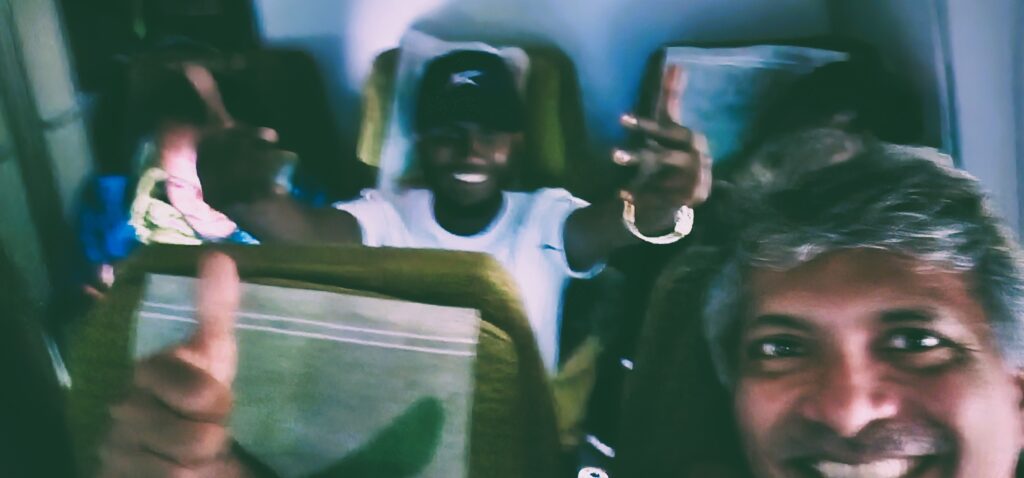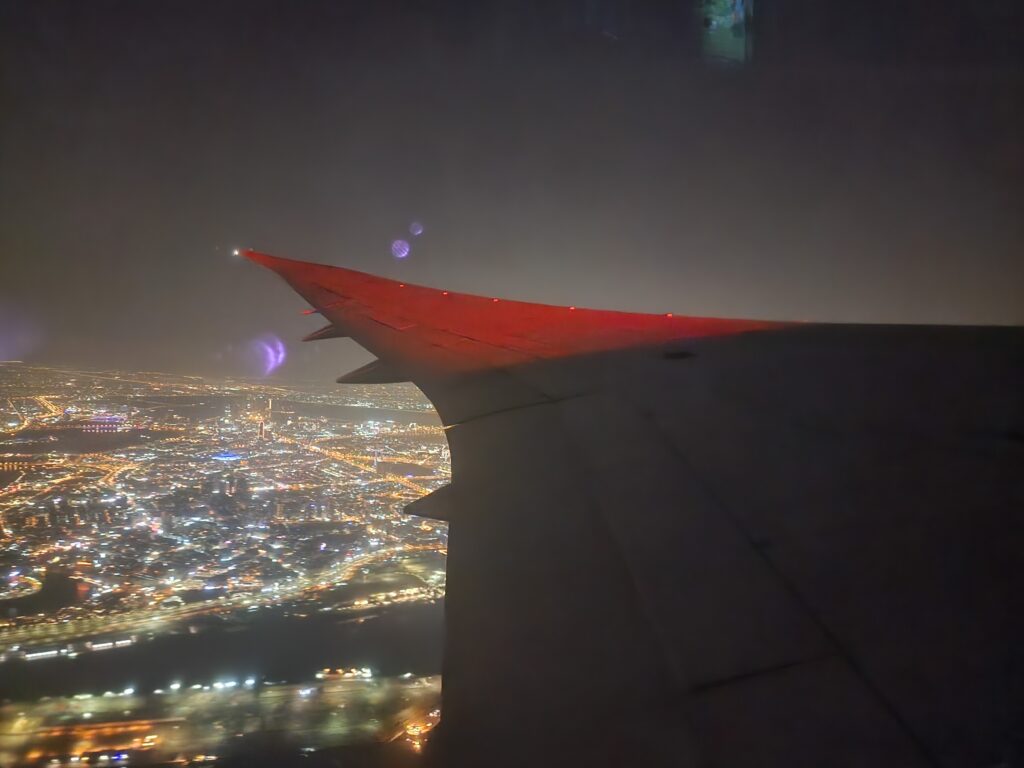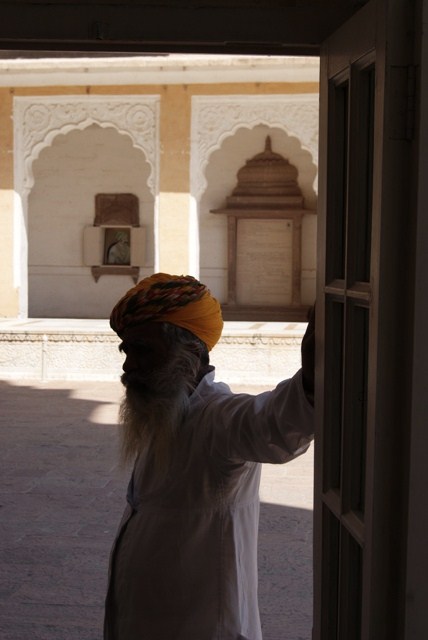I prayed and offered my soul to God. Then I took Susan’s hand and held it tight. She was crying. I told her it was good that we are together – if we are to die, we will die in each other’s arms. Of course, not that it stopped her from crying. Bob
On my part, I was going over the photographs I took taking off from Dubai and imagining the best possible ways to crash land – and hoping the pilot share my plan. I almost always do, take photographs that is, from an airplane window. Especially if I don’t have to lean over somebody’s stomach or other protruding body parts. Or if there is something interesting outside. This time it was The World Islands: the much-speculated archipelago made of dredged up sand off the coast of Dubai designed to look like the world in miniature. As is typical of the emirate, this too a grand project on a mammoth scale involving billions of dollars. Started in the early 2000s but ran aground after the financial crash in 2008. A cautious revival is on now.

Despite the environmental impact like reduction in aquatic life and degradation of the marine ecosystem I was stupefied by the scale and ambition. If you have read my earlier posts on the iconic Signature Bridge in Delhi, a project I was associated with for many years filming and documenting, you will know that I am all for manmade marvels. How else do we justify our existence and mark our era for posterity? Or make future historians look back with respect and drive the scientifically inclined to greater heights?
Revisiting the photographs, I peered close for any sign of construction or inhabitation. With little or no information forthcoming from the flight deck, my mind ran amok. I looked around me and it was tranquil in the cabin. What a cool bunch of passengers, I thought, mostly Africans. Later I found that they were all thinking about God and loved ones, preparing for the worst. But they sat, quiet and composed. Some were of course fidgety like a kid who just discovered the oobleck. If it were Indians, I am sure half the phones would be out, trying to reach somebody, to assure them of their love and meetings in afterlife.
‘I never got the opportunity to tell you (because I never thought I would die) that I love you.’
The escape blueprint
Fuel dumping/jettisoning went on which I watched enthralled through my window and filmed with my phone camera. Crash landing was ruled out because I couldn’t see or smell smoke, there weren’t forced-calm announcements, yaws, or oxygen masks dangling. But clearly there was going to be an unnatural landing – be it forced or precautionary. Fuel jettison is carried out when overweight landing is not advised even though Boeing website confusingly says, ‘landing overweight and jettisoning fuel are both considered safe procedures.’ Probably they mean in different circumstances. Most planes are not able to land safely at take-off weights making ridding of fuel during emergency landings a necessary, precautionary move.

Looking at the World Island photographs, I told myself that any pilot with minimum flying experience, and some of Sully in him, would be able to take us through this. Ditching could be ruled out thanks to the intermittent blobs of land available – we had turned around halfway, and I could see the desert kingdom like the cosmos on earth. We just had to come in from the seaside, gear up, a controlled sink rate, and aim for one of the islands. Preferably one with few workers – who could all scramble into the water any way – a couple of fire engines, an ambulance, and a coffee and shawarma shop, if you will. Now only if I could communicate my plans to the pilot.
I looked around.
Kind inattention please
A note to all who asked me to name the airline when I narrated the incident after it happened around mid of June, and to those who will after reading this: I am not revealing the airline identity not because I am in aviation or the airline’s top brass are acquaintances, but because it is not relevant – emergencies are for anyone.
The Airbus safety guide says that in cases of emergency landing, the main role of the crew is to ‘clearly communicate the situation to passengers and ultimately get everyone off the plane safely.’ Because things may not necessarily lead to the latter doesn’t mean you ignore the former.
I asked one of the ground staff who came onboard after landing what went wrong. ‘A minor flap issue,’ he said. A spot of primary research shows usual reasons for emergency landing being deteriorating weather, gradually developing engine trouble, fuel shortage, or just getting lost. Though this might raise a lot of brows over the type of weather instruments we use or the quality and commitment of engineers airlines appoint, let’s go with it.
On flaps: They are useful but ‘minor issues’ do not warrant thousands of dollars burned up – not just the cost of aviation fuel dumped but ground charges and provisions for passengers including making up for missed connections. Flaps are useful, yes. But aircrafts have flown and landed with damaged flaps without incident.

The only announcement from the pilot was regarding the fuel being pumped out through the left wing right next door to me. I was already looking at it, a short-lived atmospheric river. Aviation fuel at high altitudes vaporize in a jiffy. I pointed it out to my fellow passenger, Simon, who just sat, stared, and smiled. With good reason – read his story later.
‘Nothing to worry,’ the public announcement went. ‘What you see is jettisoning of fuel – as we empty our fuel tanks preparing for an emergency landing.’
The airline – I have flown it on many occasions before – starts serving its cuisine involving great beef with decent wine not long after it has stopped climbing, an event I look forward to. This time there were no signs of the food cart. Must be SOP, I get it. Then the whole crew just disappeared into the galley or wherever. We landed with just one vehicle with rotating lights following us. Afterwards the passengers were made to sit inside for over an hour – with the crew missing again. But this time many of us made our way towards the pantry and helped ourselves to water and juice. A kerfuffle ensued with passengers demanding to know why information wasn’t forthcoming – or why were denied even basics like water.
The story of Simon Smith
The landing was met with an extended applause. It was also when I realized that things weren’t so cool, after all; people were on the edge. The composure was just a façade, right beneath which simmered fear of death and indignation at being kept in the dark. Simon, who sat next to me, seemed to be the only other one like me – who wasn’t really worried about safety and staying alive, as if we took them for granted. I told him that I even imagined taking flak for picking up my laptop while emergency evacuation was underway. However, I’d still wait for the lady across the aisle with the LV bag to pick hers, first.
“I didn’t really care,” Simon said. “Those few hours of freedom would have been worth it for me.”

Recently decarcerated, Simon was a teacher from Accra who worked as a hospital attendant in Dubai for two years. He lost his job after the pandemic and didn’t have the money to renew his Emirates ID, the government-issued identity card. The overstay landed him a prison term, he was behind bars for nearly a year. During our conversations, he would keep coming back to freedom: how it was more important than money, women, love, religion, food, all. He was going home now after having earned his freedom, served his sentence. Simon didn’t tell his family he was coming back as it might disappoint them but just his then girlfriend, a colleague from his teaching days.
“Is she waiting for you?” I had to know.
“I have no idea,” he replied. “Honestly, I don’t care. I am still enjoying my freedom.”
There were several waves of applause and high fives – dumb as it was, but relief slapping through. Everyone talked to everyone else. Familiarity with the unfamiliar was a warm African trait; I have seen perfect strangers talk to each other like they have known each other for years. An ordeal brings people together, glues them in a way. In the confusing and consoling melee that ensued new friends were made, and phone numbers exchanged. Promises were made to meet.
Somewhere behind me a woman swooned, I decided to have a word with the purser about the still-missing crew.
Footnote
With people taking to air travel like never before there must be better codes of conduct in situations like these. Taking mutual trust and respect as a non-negotiable, a few recommendations:
- The PA in emergency situations must share every detail of the incident; keeping passengers barely informed or playing it down to contain the situation is not good practice.
- The communication must be clear, comprehensible, and frequent – not to be delivered like the welcome or flight-update perfunctory.
- If there are no violent lurches or the possibility for it, the cabin crew must be up and about – probably not serving hot meals but water and smiles. Whether you are going to be safe or going down, its good to be happy.
- While it may not be good PR but great confusion to follow protocol and evacuate a multitude on to the tarmac suddenly, it is not kind to keep them inside steaming and fainting either. Being unkind is bad for business. Yes, it’s a thin fine line, but draw it.
- While the amount of trauma is subjective, frayed nerves and disarray are given. Instead of running away from displays of contempt and distrust, the crew and ground staff must tackle it head on: again, clear communication on amends and amenities are paramount. I went through a dozen bumfuzzled sleepyheads and a full meal – at 3AM! – before I got my new flight details.
- I might be pushing it a bit here, but how about a small gift to every passenger? Like a thank you note for tiding over this, together? Or, sorry for putting you through this? It is paramount you win them back. Like in any relationship, in aviation too crises pose opportunities not to be missed.





